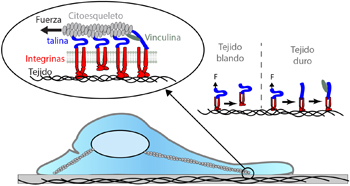The scientists and their collaborators at the Georgia Institute of Technology, publishing today in Nature Cell Biology, have identified the mechanism by which tissue stiffness activates a protein called YAP, a major oncogene. This discovery is the result of many years’ work spent studying the forces that cells apply to their surrounding tissue – forces which determine how cells proliferate, differentiate, and move, which in turn sheds light on how development, tumorigenesis or wound healing are regulated. The discovery belongs to a family of patents in place.
“Most solid tumours are stiffer than normal tissue; for example, breast cancer is usually screened by detecting hard lumps in the breast,” explains junior group leader at IBEC and assistant professor at the University of Barcelona Pere Roca-Cusachs, who led the research. “What’s more, increasing or decreasing tissue stiffness can enhance or impair tumour progression respectively.”
“Just as you would need to sit on or press a mattress to know how soft it is, cells must apply forces to their surroundings to detect stiffness,” says Alberto Elosegui-Artola, first author on the paper. “They do this through different molecules including integrins, which directly bind cells to their surrounding extracellular matrix, and talin, which connects integrins to the cytoskeleton, or body, of the cell.”

The researchers discovered that, when cells pull from those molecules while applying forces, if the substrate is stiff, the force unfolds talin, which exposes a binding domain to vinculin, which then binds and triggers the activation of YAP – one of the major players in tumour progression. If the substrate is soft, however, the force is applied slower, causing integrins to unbind from the tissue before talin can unfold, so YAP is not activated.
“This is an important first step that opens the way towards the eventual development of a new strategy that could impair the growth of many types of cancer: breast, lung, prostate, skin, and many others,” says Pere.
The work was funded in part by the Fundació la Marató de TV3.
—
Check out a video about the work on IBEC’s YouTube channel.
—
Source article: Alberto Elosegui-Artola, Roger Oria, Yunfeng Chen, Anita Kosmalska, Carlos Pérez-González, Natalia Castro, Cheng Zhu, Xavier Trepat, Pere Roca-Cusachs (2016). “Mechanical regulation of a molecular clutch defines force transmission and transduction in response to matrix rigidity.” Nature Cell Biology, DOI: 10.1038/ncb3336
Image: Images of the cell cytoskeleton while applying forces to substrates of different rigidities.